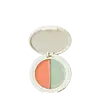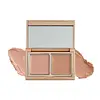What's inside
What's inside
 Key Ingredients
Key Ingredients

 Benefits
Benefits

 Concerns
Concerns

 Ingredients Side-by-side
Ingredients Side-by-side

Isononyl Isononanoate
EmollientOctyldodecanol
EmollientOctyldodecyl Stearoyl Stearate
EmollientKaolin
AbrasiveHydrogenated Castor Oil
EmollientSynthetic Wax
AbrasiveMica
Cosmetic ColorantSilica Dimethyl Silylate
EmollientSilica
AbrasiveTocopheryl Acetate
AntioxidantPhenethyl Alcohol
MaskingCaprylyl Glycol
EmollientSimmondsia Chinensis Seed Oil
EmollientLauroyl Lysine
Skin ConditioningCI 77891
Cosmetic ColorantCI 77492
Cosmetic ColorantCI 42090
Cosmetic ColorantCI 73360
Cosmetic ColorantIsononyl Isononanoate, Octyldodecanol, Octyldodecyl Stearoyl Stearate, Kaolin, Hydrogenated Castor Oil, Synthetic Wax, Mica, Silica Dimethyl Silylate, Silica, Tocopheryl Acetate, Phenethyl Alcohol, Caprylyl Glycol, Simmondsia Chinensis Seed Oil, Lauroyl Lysine, CI 77891, CI 77492, CI 42090, CI 73360
Polyglyceryl-2 Triisostearate
EmulsifyingDiisostearyl Malate
EmollientPolybutene
Triethylhexanoin
MaskingPentaerythrityl Tetraisostearate
EmollientHydrogenated Microcrystalline Cera
Mica
Cosmetic ColorantSilica
AbrasiveIsononyl Isononanoate
EmollientBis-Diglyceryl Polyacyladipate-2
EmollientCopernicia Cerifera Cera
EmollientWater
Skin ConditioningCaprylyl Glycol
EmollientHydroxyacetophenone
AntioxidantTocopheryl Acetate
AntioxidantCI 77891
Cosmetic ColorantCI 77491
Cosmetic ColorantCI 77492
Cosmetic ColorantCI 19140
Cosmetic ColorantCI 42090
Cosmetic ColorantCI 77499
Cosmetic ColorantPolyglyceryl-2 Triisostearate, Diisostearyl Malate, Polybutene, Triethylhexanoin, Pentaerythrityl Tetraisostearate, Hydrogenated Microcrystalline Cera, Mica, Silica, Isononyl Isononanoate, Bis-Diglyceryl Polyacyladipate-2, Copernicia Cerifera Cera, Water, Caprylyl Glycol, Hydroxyacetophenone, Tocopheryl Acetate, CI 77891, CI 77491, CI 77492, CI 19140, CI 42090, CI 77499
Ingredients Explained
These ingredients are found in both products.
Ingredients higher up in an ingredient list are typically present in a larger amount.
Caprylyl Glycol is a humectant and emollient, meaning it attracts and preserves moisture.
It is a common ingredient in many products, especially those designed to hydrate skin. The primary benefits are retaining moisture, skin softening, and promoting a healthy skin barrier.
Though Caprylyl Glycol is an alcohol derived from fatty acids, it is not the kind that can dry out skin.
This ingredient is also used as a preservative to extend the life of products. It has slight antimicrobial properties.
Learn more about Caprylyl GlycolCi 42090 is a synthetic dye created from petroleum. It is used to give a bright blue color to cosmetics, medicine, and food.
Ci 77492 is also hydrated iron III oxide. It's sole purpose is to give a yellow hue to products.
Iron III oxides are classified as inorganic chemicals for coloring.
Synthetically created Ci 77492 is considered safer than those naturally found. This is because the synthetically created version may contain less impurities. Iron oxides are generally non-toxic and non-allergenic.
Learn more about CI 77492Ci 77891 is a white pigment from Titanium dioxide. It is naturally found in minerals such as rutile and ilmenite.
It's main function is to add a white color to cosmetics. It can also be mixed with other colors to create different shades.
Ci 77891 is commonly found in sunscreens due to its ability to block UV rays.
Learn more about CI 77891Isononyl Isononanoate is a synthetic skin-conditioner and texture enhancer. It is created from nonanoic acid, a fatty acid found in cocoa and lavender oil.
As an emollient, Isononyl Isononanoate helps keep your skin soft and smooth. This is because emollients create a barrier on the skin to trap moisture in.
Isononyl Isononanoate helps give products a velvet feel and improves spreadability.
Learn more about Isononyl IsononanoateMica is a naturally occurring mineral used to add shimmer and color in cosmetics. It can also help improve the texture of a product or give it an opaque, white/silver color.
Serecite is the name for very fine but ragged grains of mica.
This ingredient is often coated with metal oxides like titanium dioxide. Trace amounts of heavy metals may be found in mica, but these metals are not harmful in our personal products.
Mica has been used since prehistoric times throughout the world. Ancient Egyptian, Indian, Greek, Roman, Aztec, and Chinese civilizations have used mica.
Learn more about MicaSilica, also known as silicon dioxide, is a naturally occurring mineral. It is used as a fine, spherical, and porous powder in cosmetics.
Though it has exfoliant properties, the function of silica varies depending on the product.
The unique structure of silica enhances the spreadability and adds smoothness, making it a great texture enhancer.
It is also used as an active carrier, emulsifier, and mattifier due to its ability to absorb excess oil.
In some products, tiny microneedles called spicules are made from silica or hydrolyzed sponge. When you rub them in, they lightly polish away dead skin layers and enhance the penetration of active ingredients.
Learn more about SilicaTocopheryl Acetate is AKA Vitamin E. It is an antioxidant and protects your skin from free radicals. Free radicals damage the skin by breaking down collagen.
One study found using Tocopheryl Acetate with Vitamin C decreased the number of sunburned cells.
Tocopheryl Acetate is commonly found in both skincare and dietary supplements.
Learn more about Tocopheryl Acetate